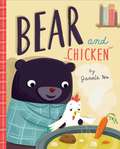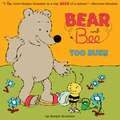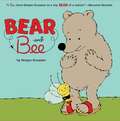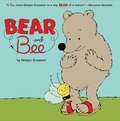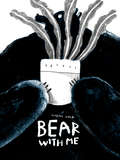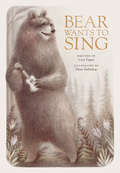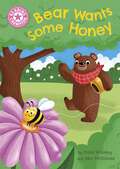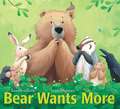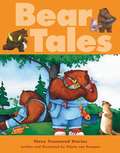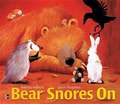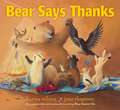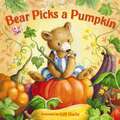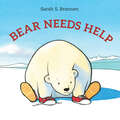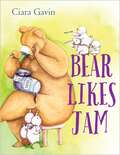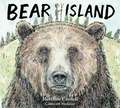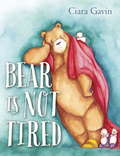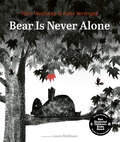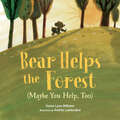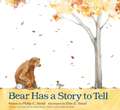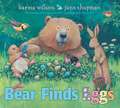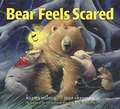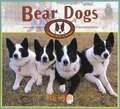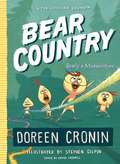- Table View
- List View
Bear and Chicken
by Jannie HoHumor, a surprise ending, and an unlikely friendship make Bear and Chicken fall into the ranks with Mo Willems and Dev Petty, and the soup recipe at the end will inspire young chefs to get into the kitchen and cook! When Bear finds a chicken frozen in the winter snow, he brings it home to try to defrost it. As Chicken thaws-um, awakens-he fears that Bear is actually prepping to eat him. Oh no! All signs are pointing to a fateful end for Chicken-being wrapped like a burrito, chopped basil and veggies sitting on the counter, the huge pot on the stove that's just the right size for a chicken to fit inside.It's almost time for lunch, so Chicken makes a run for it! But in the end, Chicken learns that perhaps he too quickly jumped to conclusions. This funny and clever friendship tale teaches kids that things are not always as they seem, while learning a thing or two about making soup with a friend!
Bear and Bee Too Busy (Bear and Bee)
by Sergio RuzzierWhen Bear asks Bee to roll down the hill with him, Bee is too busy. Bee is too busy to lie in the sun and splash in the water, too. And by the time Bee asks Bear to watch the moon with her, he is too sleepy! Poor Bear. Poor Bee. Nothing is fun without your best friend beside you, but luckily Bee knows just what to do!
Bear and Bee (Bear and Bee)
by Sergio RuzzierAfter a nice long hibernation, Bear wakes up and craves some honey. When he spots a beehive in the distance, he heads right for it! Sitting on top of the beehive is Bee who graciously offers Bear some honey, but Bear is worried. He believes that bees are big, scary creatures who do not share their honey. But Bear's new friend just happens to be a bee! And Bee is small and most certainly is not scary. But do bees share honey? Turns out they do!
Bear and Bee
by Sergio RuzzierA hungry bear discovers that bees are not terrible monsters who never share their honey.
Bear With Me
by Noemi VolaWhat do you do with a bear who won&’t leave? When a bear comes to stay, no one expects him to stay too long! But his arrival changes everything, from sleeping to shopping to hanging out with friends. If even dinosaurs and math problems can&’t drive him away, what are you supposed to do?Featuring quirky, energetic illustrations, this amusing tale suggests we can learn to live with even the most unbearable company.
Bear Wants to Sing
by Cary FaganBear wants to sing his song, but the other animals won't give him a chance to perform his masterwork in this delightful picture book companion to the critically acclaimed King Mouse.A bear finds a ukulele in the woods. It makes a nice sound -- PLINK! -- and inspires him to write his own song. His friend Mouse would love to hear it. But Bear isn't the only animal in the forest to find musical inspiration that day, and Snake, Crow and Tortoise keep taking his turn to perform. When they finally give him the opportunity and meet his song with less enthusiasm than he'd like, the discouraged bear shelves his music career forever . . . but the kindness, empathy and appreciation of his best friend will prove that his art deserves recognition and can even inspire others.This dryly humorous and sweetly profound collaboration between two critically acclaimed children's book creators, a follow-up to the masterful King Mouse, has the makings of a modern classic.
Bear Wants Some Honey: Independent Pink 1a (Reading Champion #516)
by Katie WoolleyThis story is part of Reading Champion, a series carefully linked to book bands to encourage independent reading skills, developed with Dr Sue Bodman and Glen Franklin of UCL Institute of Education (IOE)Bear has run out of honey, and he wants some more. When he spots a bee in the garden, he knows just what to do!Reading Champion offers independent reading books for children to practise and reinforce their developing reading skills.Fantastic, original stories are accompanied by engaging artwork and a reading activity. Each book has been carefully graded so that it can be matched to a child's reading ability, encouraging reading for pleasure. Perfect for 4-5 year olds or those reading book band pink 1a.
Bear Wants More
by Karma WilsonWhen springtime comes, in his warm winter den a bear wakes up very hungry and thin!. . . Bear finds some roots to eat, but that's not enough. He wants more! With his friends' help, he finds some berries, clover, and fish to eat, but that's not enough. Bear wants more! How Bear's friends help him to finally satisfy his HUGE hunger in a most surprising way will enchant young readers. Karma Wilson's rhythmic text and Jane Chapman's vibrant illustrations make Bear Wants More a perfect springtime read-aloud. Other books about Bear are available from Bookshare.
Bear Tales: Three Treasured Stories
by Vlasta Van Kampen"Bear and Pig Go To Market" is a humorous, Czech tale about selling and friendship. "Bear Stole the Moon" is a North-American tale explaining why the moon changes shapes. "Three Lazy Bears" is a Russian tale about the pitfalls of laziness.
Bear Snores On (Elementary Core Reading Ser.)
by Karma Wilson Jane ChapmanNIMAC-sourced textbook <P><P>On a cold winter night many animals gather to party in the cave of a sleeping bear, who then awakes and protests that he has missed the food and the fun.
Bear Shadow
by Frank AschWhen Bear tried to catch a fish, his shadow scared the fish away. And so Bear decided to get rid of his shadow.
Bear Says Thanks
by Karma WilsonWhen Bear decides to throw a feast, his friends show up one by one with different platters of delicious food to share. There is just one problem: Bear's cupboards are bare! What is he to do? Other books about Bear and his friends are available in this library.
Bear Picks a Pumpkin
by ZondervanSnuggle up in the cool fall weather with a cozy blanket, a pumpkin spice latte, and your little one as you follow the whimsical, rhyming quest of Bear on his way to find the perfect pumpkin.Will he choose a tall one? A tiny one? One with stripes? Or perhaps a pumpkin white as snow?Read along and find out which pumpkin Bear (and his friends) will choose!Here&’s a silly pumpkin! It&’s bumpy and unique. But there are still more pumpkins, So let&’s go and take a peek. Here&’s another pumpkin, Bear! It&’s perfect, don&’t you say? It&’s round and smooth and not too big— Just right for you! Hooray!Bear Picks a Pumpkin:Is perfect for little readersBlends the warmth and joy of autumn with a powerful message of friendshipIs written in soothing, rhyming text, fun to read for parents and kids alike
Bear Needs Help
by Sarah S. BrannenWith one of his shoes untied, and all of the animals too scared to help, what's Bear going to do? The surprisingly clever answer will make kids -- and parents -- laugh. A perfect read-aloud.A lumbering little polar bear has one shoe untied, and he needs some help! Sadly for him, though, the other animals are all too scared of him: the lemmings, rabbits, and seals all run away as he approaches them for assistance. What's Bear going to do? Luckily, two plucky birds are more than happy to help out and offer advice -- though probably not quite in the way that readers anticipate.In this sweet and funny book about asking for help (and receiving it), expectations are flipped in a simple but clever way.Praise for Bear Needs Help:A Junior Library Guild selection!"Laced with humor and . . . decipherable in more ways than one." --Kirkus Reviews"The silliness will likely win the day and earn a few giggles . . . Use this to bring some surprising goofiness to a bear-themed or winter-themed storytime." --BCCB
Bear Likes Jam
by Ciara GavinOn the heels of Bear Is Not Tired comes a delicious new story of a big bear with an even bigger sweet tooth—perfect for fans of Karma Wilson&’s Bear Wants More. When Bear discovers jam for the time, he can&’t think of anything else. Mama Duck tells him that growing bears need to eat their vegetables first . . . but Bear can&’t stand the strange green things on his plate. He only wants jam! It&’s not until Bear notices the little ducks around him eating ALL of their food, that it finally clicks: Bear can have his dinner and his jam. This tender follow-up to Bear Is Not Tired will hit home with every family of finicky eaters. Praise for Bear Is Not Tired: &“Gavin&’s watercolors offer humor and tenderness in equal supply, making this blended family irresistible.&” —Publishers Weekly, starred review &“Warm and wonderful.&” —Kirkus Reviews on Bear Is Not Tired
Bear Island
by Matthew CordellLouise and her family are sad over the loss of their beloved dog, Charlie. "Life will not be the same," Louise says, as she visits a little island that Charlie loved.But on a visit to the island after Charlie's death, something strange happens: She meets a bear. At first, she's afraid, but soon she realizes that the bear is sad, too. As Louise visits more often, she realizes that getting over loss takes time. And just when she starts to feel better, it's time for Bear to bed down for the winter.Once again, Louise believes that life will not be the same. But sometimes, things can change for the better, and on the first warm day of spring, her family welcomes a new member. Here is a lovely, poignant story about loss and healing that will bring comfort to even the youngest readers.
Bear Is Not Tired
by Ciara GavinFor fans of Karma Wilson's Bear Snores On comes a whimsical bedtime story about a bear who is absolutely, positively not sleepy at all. . . . Bear and his duck family do everything together. That is, until winter arrives. Bear is supposed to hibernate this time of year, but he doesn't want to miss out on any of the fun. But can Bear really stay awake all winter long? Gentle humor and endearing illustrations bring a delightful twist to a bedtime routine that children and their parents will easily recognize.
Bear Is Never Alone
by Marc VeerkampA stirring, thoughtful story about the pressure to perform and the support of a true friend.When Bear sits down at the piano, he makes beautiful music, and the other animals can&’t get enough. &“More, more, Pianobear!&” they shout. But sometimes Bear just wants to relax. Even when he tries to escape to a quiet tree branch, the voices follow him: &“More! More! More!&” Finally Bear snaps. No one seems to understand why he&’s so upset—except Zebra. Zebra loves Bear&’s music, but she doesn&’t ask him to start playing again. Instead, she brings over a book…This moving story is the perfect companion for social-emotional lessons about choosing solitude, respecting boundaries, and building interpersonal awareness. Illustrated in striking shades of black, white, and red, Bear Is Never Alone encourages young readers to notice others&’ needs and care for them with kindness.
Bear Is Awake!: An Alphabet Story
by Hannah E. HarrisonIn this delightfully different alphabet book from the creator of Extraordinary Jane, a curious bear makes a new friend.Suddenly "awake" in the middle of winter, a "big bear" explores a "cozy cabin," which Bear of course "enters excitedly." But the cabin isn't empty--a little girl lives there. So begins an unlikely friendship and an unexpected adventure as the girl attempts to figure out what a bear is supposed to be doing in the winter. (Hint: It's not eating pancakes or visiting the library!)With her trademark humor and warmth, Hannah E. Harrison puts her own irresistible spin on the classic alphabet book. The result is a story families will treasure for years to come.
Bear Helps the Forest (Maybe You Help, Too)
by Karen Lynn WilliamsBear waits for fall as she sees the forest shift through spring and summer in this charming picture book about how the forest regrows.Bear loves jumping in leaf piles, but fall playtime ends with winter hibernation. When Bear wakes up she realizes it&’ll be a while—through spring and summer—till the leaves will fall again. While she waits, she learns about the constant work the forest does to renew her playground—and how she helps. Alongside Bear squishing through springtime mud, chomping on summer dandelions, and stretching in the early fall sun, readers will see how the forest changes with every season.
Bear Has A Story To Tell
by Philip C. Stead Erin E. SteadIt was almost winter and Bear was getting sleepy. But first, Bear had a story to tell... Bear found his friend Mouse, but Mouse was busy gathering seeds and didn't have time to listen to a story. Then Bear saw his friend Duck, but Duck was getting ready to fly south. What about his friend Toad? He was busy looking for a warm place to sleep. By the time Bear was through helping his friends get ready for winter, would anyone still be awake to hear his story?
Bear Finds Eggs (The Bear Books)
by Karma WilsonBear and his friends hunt for missing eggs in this new picture book adventure in the bestselling series. <p><p>Mama Meadowlark can’t find her eggs! Bear and his friends pitch in to help and search high and low. Each time they find an egg, they paint it with bright colors so they don’t lose it again and add it to Hare’s handy basket. Will they be able to return all the eggs to their mother? <P><P><i>Advisory: Bookshare has learned that this book offers only partial accessibility. We have kept it in the collection because it is useful for some of our members. Benetech is actively working on projects to improve accessibility issues such as these.</i> <p> <b>New York Times Bestseller</b>
Bear Feels Scared
by Karma Wilson Jane ChapmanBear is big, but the forest is bigger. A storm is brewing and he can't find his way home. The star of "Bear Feels Sick" and "Bear Snores On" returns in this delightful story about friendship and loyalty.
Bear Dogs: Canines with a Mission
by Ted WoodCarrie Hunt's dogs are obsessed with bears. These 50 pound bundles of energy and courage routinely take on 400 pound grizzly bears - and win. For centuries, Karelian Bear Dogs have been famous in Russian and Finland for their bear hunting abilities. Carrie has taught these dogs a new trick, using their instinct and energy to steer problem bears away from trouble. As people and bears come together more and more frequently - in backyards, national parks, and wilderness areas - some bears are losing their natural fear of humans, endangering people's lives, and causing hundreds of thousands of dollars of property damage each year. If a bear cannot be taught to stay away from people, it has to be destroyed. Carrie, a bear biologist, has trained her unique canine team to teach wayward bears form Montana to Alaska a lesson they will never forget. These endearing dogs, as gentle and loving with people as they are fearless with bears, are bringing a humane solution to this modern dilemma, allowing people and bears to share the wilderness they both love.
Bear Country: Bearly a Misadventure (The Chicken Squad #6)
by Doreen CroninNow an animated series on Disney Junior! The Chicken Squad is back for their sixth (mis)adventure, and this time there&’s a headless bear on the loose and the Chicken Squad&’s beloved Barbara has gone missing! A &“lip-bitingly funny&” (School Library Journal) chapter book from the bestselling author of Click, Clack, Moo and Cyclone.It&’s fall in the backyard, and though the weather is cooling down, the crime solving business is still hot. When the Chicken Squad&’s neighbor Anna McClanahanahan comes looking for her missing hamster one morning, it&’s an easy case to solve (Ziggy always takes a stroll from 6:30 to 7:15 a.m.). The Chicken Squad is now ready to settle in for a relaxing day of knitting—that is, until Ziggy points out that Barbara, the Chicken Squad&’s caretaker—the one who FEEDS THEM!!—is missing! And not only that, but there have been sightings of a headless bear in the neighborhood! Will the Chicken Squad be able to save their beloved Barbara and get some breakfast? Or will this case be too much to bear?
